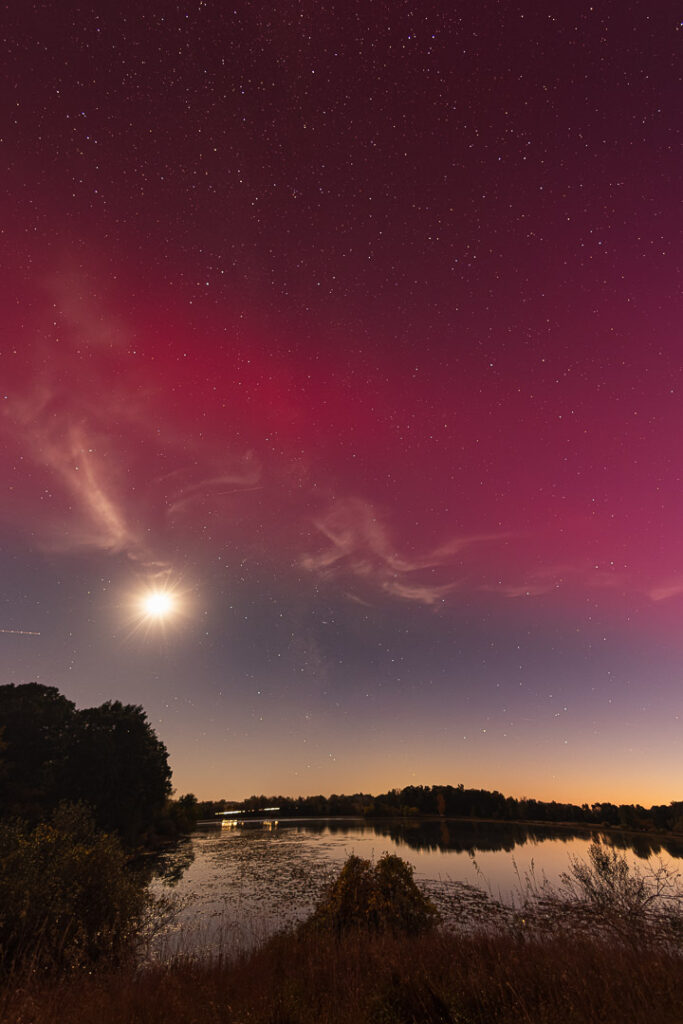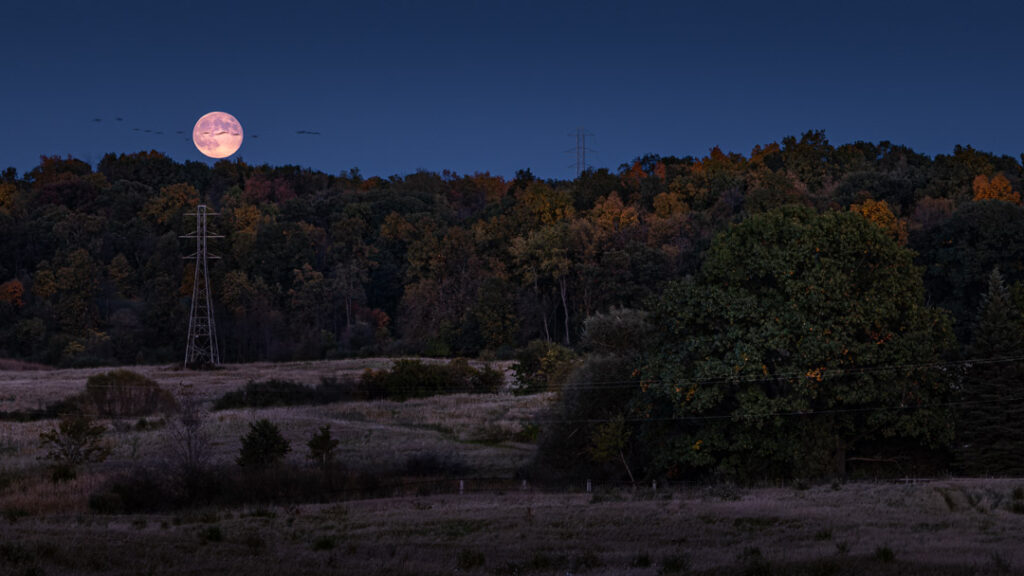I leave behind the noise and rapid pace of our modern civilization. I watch the sun slowly setting behind the hills as a stillness descends on the nature preserve. I listen to the strange sounds echoing across the lake as the flocks of Canada Geese jockey for position; waiting for the leaders to take off for the surrounding fields for their evening feed. Later, as the last glimmer of twilight settles in, they return; their wings whistle and I can almost feel the power of each downstroke as they glide low overhead into a perfect splashdown on the lake. As darkness settles the Whitetail Deer begin their nightly sojourn, grunting and blowing their dissatisfaction with my intrusion into their world. I know many people find it scary being out in the darkness in a world that feels alien, but I find it meditative and magical hiking into an area where it is just you and nature, even as the night turns to darkness.
I ventured out to Watkins Lake Preserve two weeks ago in an effort to capture comet C/2023 A3 Tsuchinan-Atlas. After last month’s attempts to view the comet in the predawn sky were stymied by weather conditions, October 12 was anticipated to be prime viewing as the comet made its closest approach to earth after sunset. With weather conditions forecast to deteriorate from the 11th on into the following week, I decided to try 2 days early.
The evening started clear as I hiked to a favorite viewing location. Using the ‘Sky Tonight’ app I identified the location low in the western sky where 2023/A3 would be visible for approximately 30-45 minutes after sunset. As was my luck, a cloud bank started rolling in from the west 30 minutes before sunset, obscuring any chance of a comet sighting that evening. Turning to Plan B, I pulled together this 5 image panorama of the western sunset over the lake. I love the silhouetted trees against the warm rich glow of the sun on the low hanging cloud cover.

As the western sky was slowly clouding over I decided to take advantage with some other astrophotography. I would start with the moon rising in the southeast, and then move on to seeing if the Milky Way might be visible. My first moon shot over the lake revealed quite a surprise; turning into my favorite image of the evening.

As the year of increased solar activity has blossomed, it has been a wild year for aurora sightings, even far into the southern states. For us in southeast Michigan it has been more difficult dealing with finding clear skies on nights with higher aurora predictions. Even when possibilities are good, actually predicting their presence and strength is still hit and miss. On this night, thanks to my ‘Aurora Pro’ app, I knew we had a chance, but not until much later in the night. So finding the strong reds in my moonlight images was a huge surprise. Interestingly the camera captures colors that are present much better than human night vision, especially in the red range. I tried other areas of the sky and captured the reds and greens.

It turned out to be a wonderful night of photography, but still no comet. I returned to the nature preserve October 17 and selected another area to hike to. The primary reason for moving location was to capture the full Hunter’s Moon rising in the east and I was in search of interesting foreground for the image. As I hiked into the area I noticed several Whitetail Deer and throughout the evening they were constantly ‘blowing’ warnings. If you’re not familiar with deer, their vocalizations can be quite unnerving, especially in the darkness. But it all seemed appropriate as I worked to capture the rising Hunter’s Moon.
The technical part of the shoot dealt with the dynamic range of the camera vs. the human eye. The camera, on average, captures 15 stops of light (the difference between dark shadows and brightest light) where our eyes see 21 stops. So shooting the moon is difficult without blowing out the highlights or losing all detail in the shadows. The easiest method to overcome this limitation is to shoot 2 images – exposing one for the moon and the second for the foreground. Then you merge them in post-processing and end up with an image exposed closer to what the human eye actually sees.
This is my version of the full Hunter’s Moon from combining two exposures. I did have an interesting version with a flock of geese in front of the moon, but the shutter speed needed to take the foreground image was too slow for a non-blurry image of the flock.

Once satisfied with imaging the moonrise, my attention turned to the western sky and comet 2023/A3. Maximum visibility was on October 12, and it was quickly moving out into space, reducing visibility without enhanced viewing capability. Once again the app was useful to locate approximately where the comet should be. Using my 16mm lens I was able to take several shots of the sky, with a slow enough shutter speed, to enhance light capture without getting blur from the earth’s rotation; a fine balance. When I checked the camera viewfinder it was a eureka moment.

The night was rapidly chilling down and I had been standing in one location for several hours. Having met my goals for the photo shoot I decided to call it a night and head home. But the night sky was so beautiful I decided on one last panoramic image to close out my October astrophotography adventures. If you look closely the comet is visible in the center directly over the large shrubbery.

October proved to be pretty exciting for shooting the night sky and I hope you enjoyed it as much as I did each evening. I’m thinking it is time to concentrate on some seasonal fall colors over the next month so stay tuned. If you enjoyed this Journal entry, please drop me a comment below, feel free to share with your friends, and visit my website Terrance Alexander Photography.
Terrance Alexander